Case Study: Analyzing the Role of ERP Systems in Nike's Operations
VerifiedAdded on 2022/09/22
|10
|2299
|21
Case Study
AI Summary
This case study examines the implementation of Enterprise Resource Planning (ERP) systems at Nike. It details Nike's initial struggles with a demand planning system, highlighting issues with coding, user expertise, and data accuracy. The analysis then shifts to Nike's successful ERP implementation, emphasizing the importance of learning from past mistakes, comprehensive employee training, and the use of Business Process Reengineering (BPR). The report discusses the phased rollout strategy Nike employed, starting with a trial in Canada and expanding globally, to mitigate risks and ensure effective system adoption across its various divisions. The study emphasizes the key factors contributing to Nike's ERP success, including a user-friendly interface, real-time data management, and the adaptation of existing systems to meet business objectives. The analysis offers valuable insights into the challenges and strategies associated with ERP implementation in a large multinational corporation.

Running head: TITLE ROLE OF ERP SYSTEMS IN NIKE
ROLE OF ERP SYSTEMS IN NIKE
Name of the student:
Name of the university:
Author Note:
ROLE OF ERP SYSTEMS IN NIKE
Name of the student:
Name of the university:
Author Note:
Paraphrase This Document
Need a fresh take? Get an instant paraphrase of this document with our AI Paraphraser
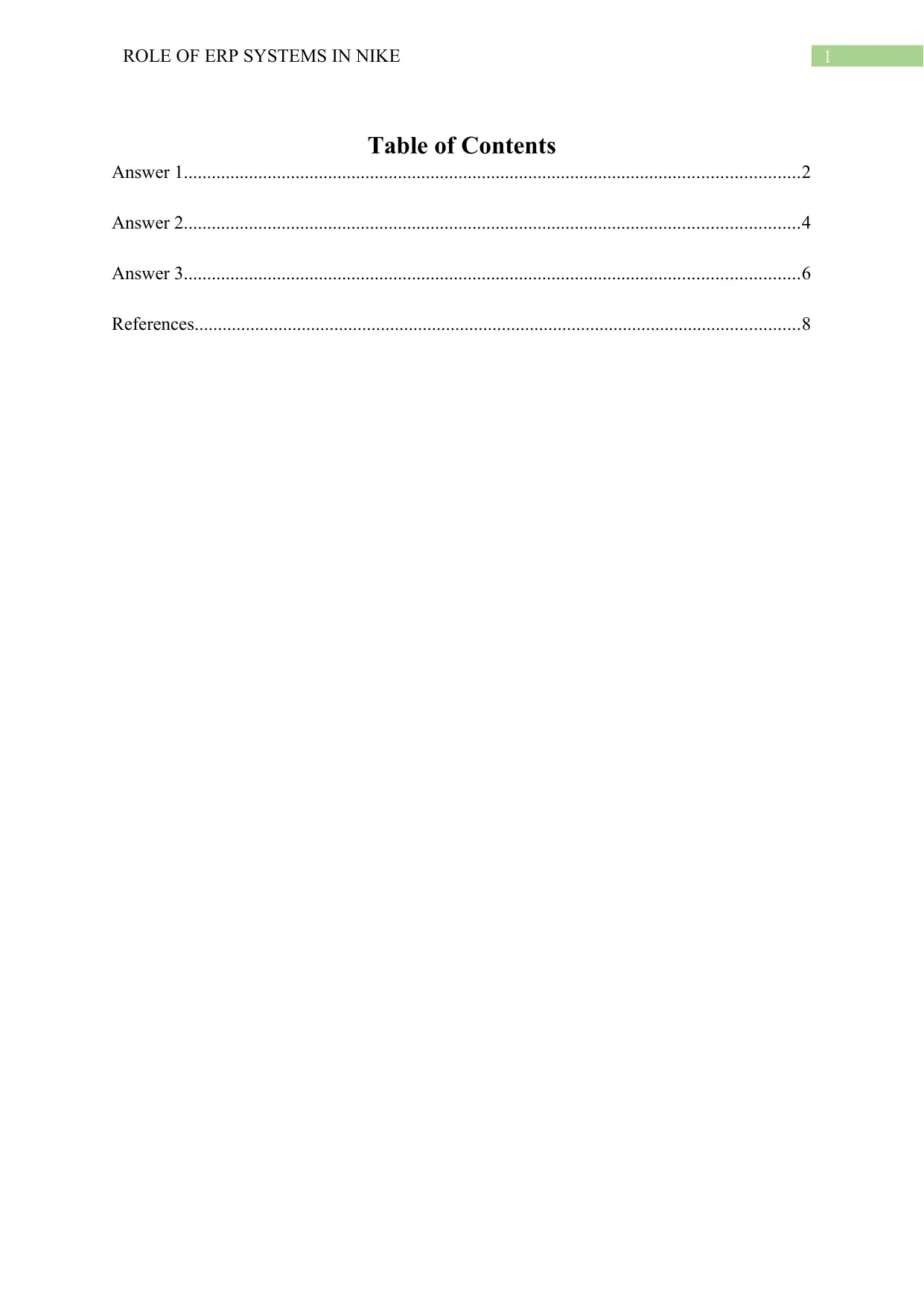
1ROLE OF ERP SYSTEMS IN NIKE
Table of Contents
Answer 1....................................................................................................................................2
Answer 2....................................................................................................................................4
Answer 3....................................................................................................................................6
References..................................................................................................................................8
Table of Contents
Answer 1....................................................................................................................................2
Answer 2....................................................................................................................................4
Answer 3....................................................................................................................................6
References..................................................................................................................................8
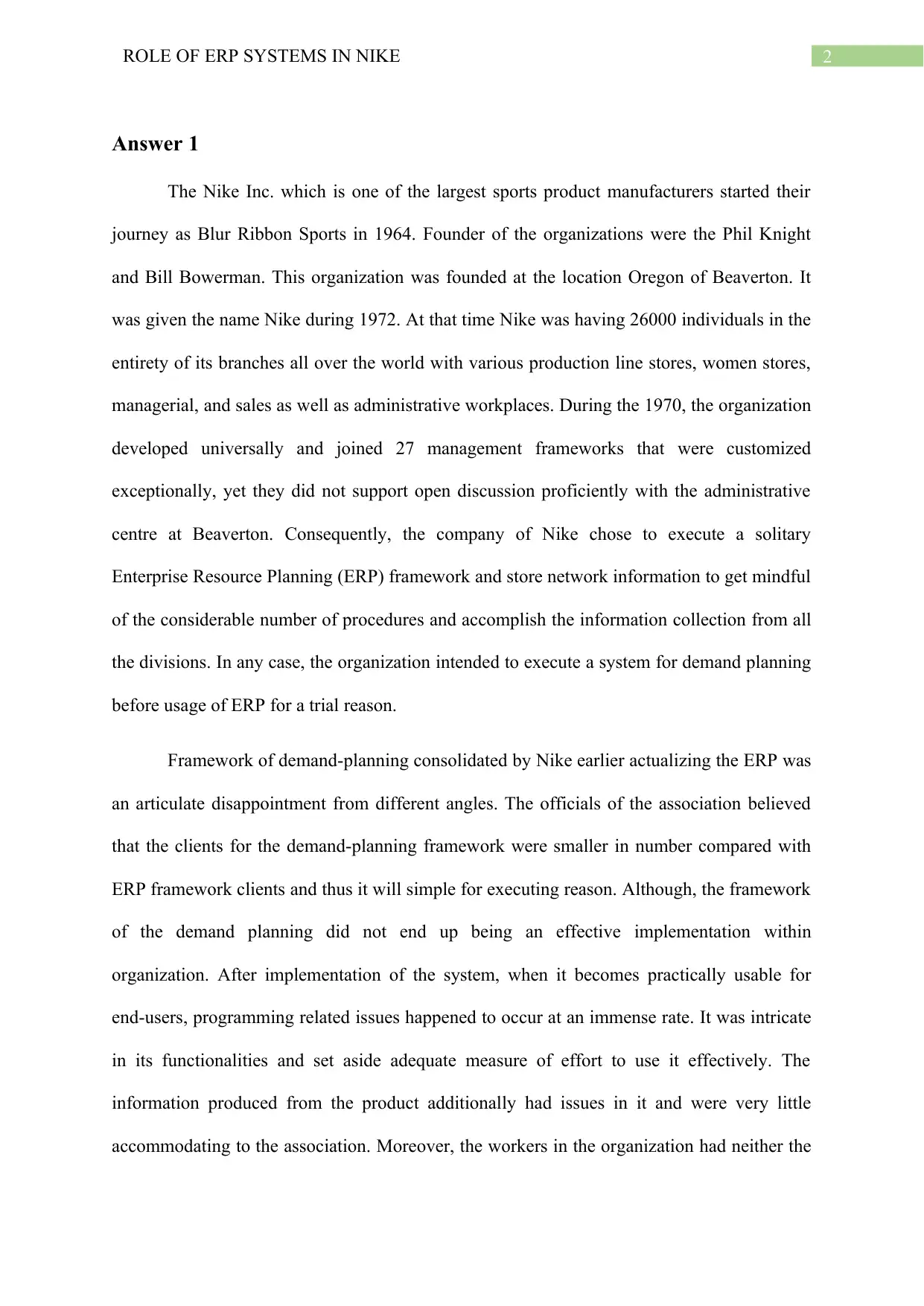
2ROLE OF ERP SYSTEMS IN NIKE
Answer 1
The Nike Inc. which is one of the largest sports product manufacturers started their
journey as Blur Ribbon Sports in 1964. Founder of the organizations were the Phil Knight
and Bill Bowerman. This organization was founded at the location Oregon of Beaverton. It
was given the name Nike during 1972. At that time Nike was having 26000 individuals in the
entirety of its branches all over the world with various production line stores, women stores,
managerial, and sales as well as administrative workplaces. During the 1970, the organization
developed universally and joined 27 management frameworks that were customized
exceptionally, yet they did not support open discussion proficiently with the administrative
centre at Beaverton. Consequently, the company of Nike chose to execute a solitary
Enterprise Resource Planning (ERP) framework and store network information to get mindful
of the considerable number of procedures and accomplish the information collection from all
the divisions. In any case, the organization intended to execute a system for demand planning
before usage of ERP for a trial reason.
Framework of demand-planning consolidated by Nike earlier actualizing the ERP was
an articulate disappointment from different angles. The officials of the association believed
that the clients for the demand-planning framework were smaller in number compared with
ERP framework clients and thus it will simple for executing reason. Although, the framework
of the demand planning did not end up being an effective implementation within
organization. After implementation of the system, when it becomes practically usable for
end-users, programming related issues happened to occur at an immense rate. It was intricate
in its functionalities and set aside adequate measure of effort to use it effectively. The
information produced from the product additionally had issues in it and were very little
accommodating to the association. Moreover, the workers in the organization had neither the
Answer 1
The Nike Inc. which is one of the largest sports product manufacturers started their
journey as Blur Ribbon Sports in 1964. Founder of the organizations were the Phil Knight
and Bill Bowerman. This organization was founded at the location Oregon of Beaverton. It
was given the name Nike during 1972. At that time Nike was having 26000 individuals in the
entirety of its branches all over the world with various production line stores, women stores,
managerial, and sales as well as administrative workplaces. During the 1970, the organization
developed universally and joined 27 management frameworks that were customized
exceptionally, yet they did not support open discussion proficiently with the administrative
centre at Beaverton. Consequently, the company of Nike chose to execute a solitary
Enterprise Resource Planning (ERP) framework and store network information to get mindful
of the considerable number of procedures and accomplish the information collection from all
the divisions. In any case, the organization intended to execute a system for demand planning
before usage of ERP for a trial reason.
Framework of demand-planning consolidated by Nike earlier actualizing the ERP was
an articulate disappointment from different angles. The officials of the association believed
that the clients for the demand-planning framework were smaller in number compared with
ERP framework clients and thus it will simple for executing reason. Although, the framework
of the demand planning did not end up being an effective implementation within
organization. After implementation of the system, when it becomes practically usable for
end-users, programming related issues happened to occur at an immense rate. It was intricate
in its functionalities and set aside adequate measure of effort to use it effectively. The
information produced from the product additionally had issues in it and were very little
accommodating to the association. Moreover, the workers in the organization had neither the
⊘ This is a preview!⊘
Do you want full access?
Subscribe today to unlock all pages.

Trusted by 1+ million students worldwide
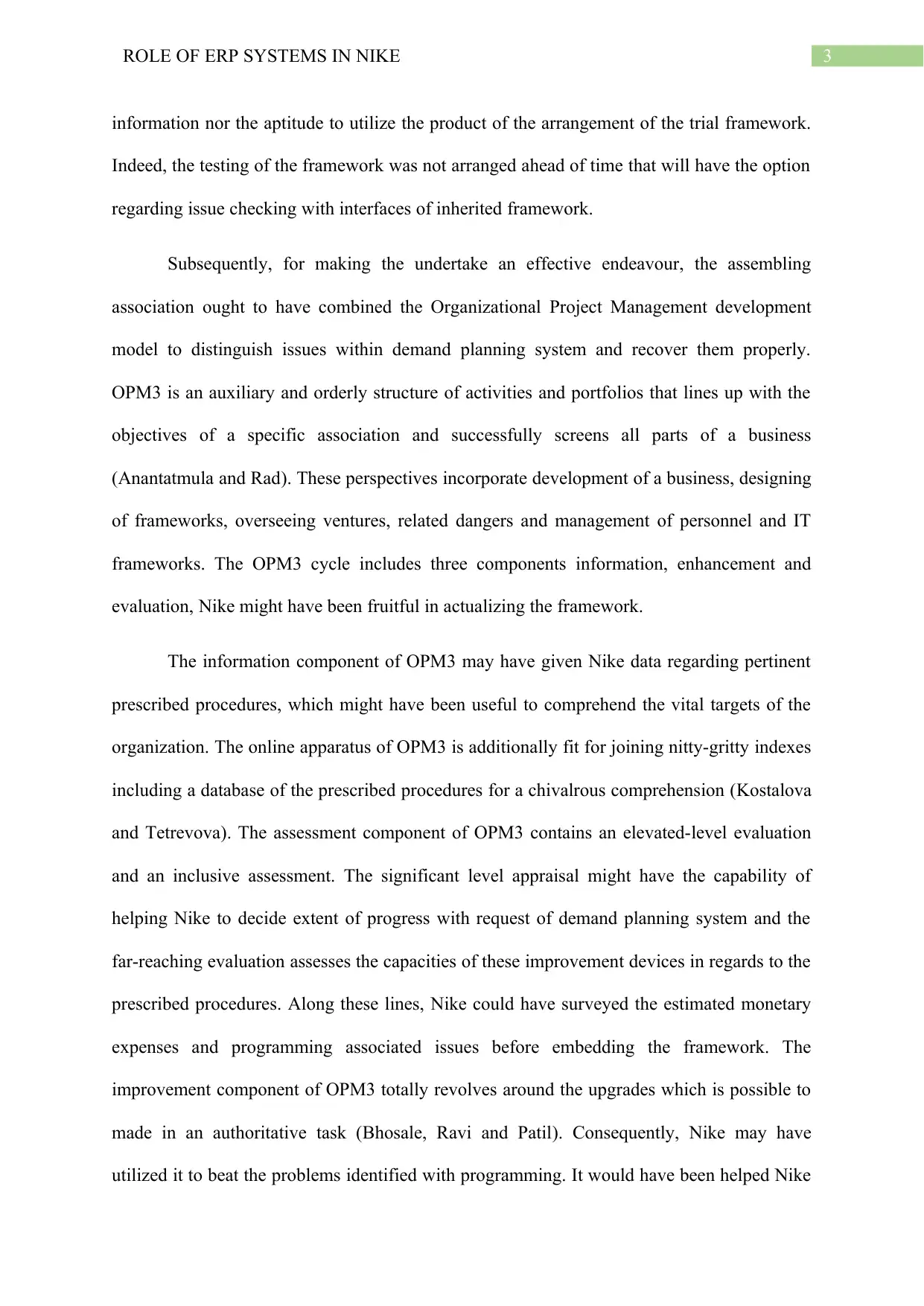
3ROLE OF ERP SYSTEMS IN NIKE
information nor the aptitude to utilize the product of the arrangement of the trial framework.
Indeed, the testing of the framework was not arranged ahead of time that will have the option
regarding issue checking with interfaces of inherited framework.
Subsequently, for making the undertake an effective endeavour, the assembling
association ought to have combined the Organizational Project Management development
model to distinguish issues within demand planning system and recover them properly.
OPM3 is an auxiliary and orderly structure of activities and portfolios that lines up with the
objectives of a specific association and successfully screens all parts of a business
(Anantatmula and Rad). These perspectives incorporate development of a business, designing
of frameworks, overseeing ventures, related dangers and management of personnel and IT
frameworks. The OPM3 cycle includes three components information, enhancement and
evaluation, Nike might have been fruitful in actualizing the framework.
The information component of OPM3 may have given Nike data regarding pertinent
prescribed procedures, which might have been useful to comprehend the vital targets of the
organization. The online apparatus of OPM3 is additionally fit for joining nitty-gritty indexes
including a database of the prescribed procedures for a chivalrous comprehension (Kostalova
and Tetrevova). The assessment component of OPM3 contains an elevated-level evaluation
and an inclusive assessment. The significant level appraisal might have the capability of
helping Nike to decide extent of progress with request of demand planning system and the
far-reaching evaluation assesses the capacities of these improvement devices in regards to the
prescribed procedures. Along these lines, Nike could have surveyed the estimated monetary
expenses and programming associated issues before embedding the framework. The
improvement component of OPM3 totally revolves around the upgrades which is possible to
made in an authoritative task (Bhosale, Ravi and Patil). Consequently, Nike may have
utilized it to beat the problems identified with programming. It would have been helped Nike
information nor the aptitude to utilize the product of the arrangement of the trial framework.
Indeed, the testing of the framework was not arranged ahead of time that will have the option
regarding issue checking with interfaces of inherited framework.
Subsequently, for making the undertake an effective endeavour, the assembling
association ought to have combined the Organizational Project Management development
model to distinguish issues within demand planning system and recover them properly.
OPM3 is an auxiliary and orderly structure of activities and portfolios that lines up with the
objectives of a specific association and successfully screens all parts of a business
(Anantatmula and Rad). These perspectives incorporate development of a business, designing
of frameworks, overseeing ventures, related dangers and management of personnel and IT
frameworks. The OPM3 cycle includes three components information, enhancement and
evaluation, Nike might have been fruitful in actualizing the framework.
The information component of OPM3 may have given Nike data regarding pertinent
prescribed procedures, which might have been useful to comprehend the vital targets of the
organization. The online apparatus of OPM3 is additionally fit for joining nitty-gritty indexes
including a database of the prescribed procedures for a chivalrous comprehension (Kostalova
and Tetrevova). The assessment component of OPM3 contains an elevated-level evaluation
and an inclusive assessment. The significant level appraisal might have the capability of
helping Nike to decide extent of progress with request of demand planning system and the
far-reaching evaluation assesses the capacities of these improvement devices in regards to the
prescribed procedures. Along these lines, Nike could have surveyed the estimated monetary
expenses and programming associated issues before embedding the framework. The
improvement component of OPM3 totally revolves around the upgrades which is possible to
made in an authoritative task (Bhosale, Ravi and Patil). Consequently, Nike may have
utilized it to beat the problems identified with programming. It would have been helped Nike
Paraphrase This Document
Need a fresh take? Get an instant paraphrase of this document with our AI Paraphraser
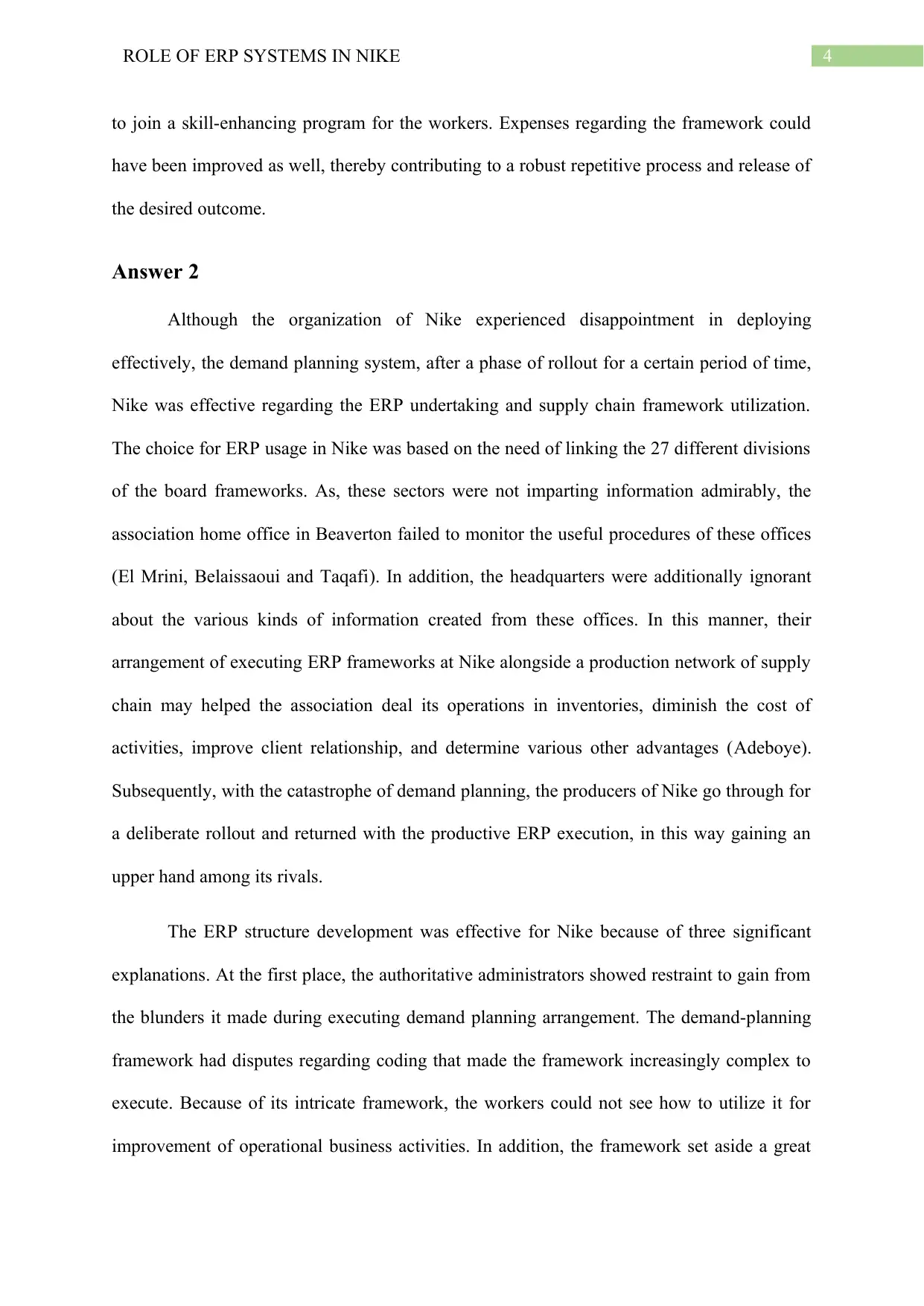
4ROLE OF ERP SYSTEMS IN NIKE
to join a skill-enhancing program for the workers. Expenses regarding the framework could
have been improved as well, thereby contributing to a robust repetitive process and release of
the desired outcome.
Answer 2
Although the organization of Nike experienced disappointment in deploying
effectively, the demand planning system, after a phase of rollout for a certain period of time,
Nike was effective regarding the ERP undertaking and supply chain framework utilization.
The choice for ERP usage in Nike was based on the need of linking the 27 different divisions
of the board frameworks. As, these sectors were not imparting information admirably, the
association home office in Beaverton failed to monitor the useful procedures of these offices
(El Mrini, Belaissaoui and Taqafi). In addition, the headquarters were additionally ignorant
about the various kinds of information created from these offices. In this manner, their
arrangement of executing ERP frameworks at Nike alongside a production network of supply
chain may helped the association deal its operations in inventories, diminish the cost of
activities, improve client relationship, and determine various other advantages (Adeboye).
Subsequently, with the catastrophe of demand planning, the producers of Nike go through for
a deliberate rollout and returned with the productive ERP execution, in this way gaining an
upper hand among its rivals.
The ERP structure development was effective for Nike because of three significant
explanations. At the first place, the authoritative administrators showed restraint to gain from
the blunders it made during executing demand planning arrangement. The demand-planning
framework had disputes regarding coding that made the framework increasingly complex to
execute. Because of its intricate framework, the workers could not see how to utilize it for
improvement of operational business activities. In addition, the framework set aside a great
to join a skill-enhancing program for the workers. Expenses regarding the framework could
have been improved as well, thereby contributing to a robust repetitive process and release of
the desired outcome.
Answer 2
Although the organization of Nike experienced disappointment in deploying
effectively, the demand planning system, after a phase of rollout for a certain period of time,
Nike was effective regarding the ERP undertaking and supply chain framework utilization.
The choice for ERP usage in Nike was based on the need of linking the 27 different divisions
of the board frameworks. As, these sectors were not imparting information admirably, the
association home office in Beaverton failed to monitor the useful procedures of these offices
(El Mrini, Belaissaoui and Taqafi). In addition, the headquarters were additionally ignorant
about the various kinds of information created from these offices. In this manner, their
arrangement of executing ERP frameworks at Nike alongside a production network of supply
chain may helped the association deal its operations in inventories, diminish the cost of
activities, improve client relationship, and determine various other advantages (Adeboye).
Subsequently, with the catastrophe of demand planning, the producers of Nike go through for
a deliberate rollout and returned with the productive ERP execution, in this way gaining an
upper hand among its rivals.
The ERP structure development was effective for Nike because of three significant
explanations. At the first place, the authoritative administrators showed restraint to gain from
the blunders it made during executing demand planning arrangement. The demand-planning
framework had disputes regarding coding that made the framework increasingly complex to
execute. Because of its intricate framework, the workers could not see how to utilize it for
improvement of operational business activities. In addition, the framework set aside a great
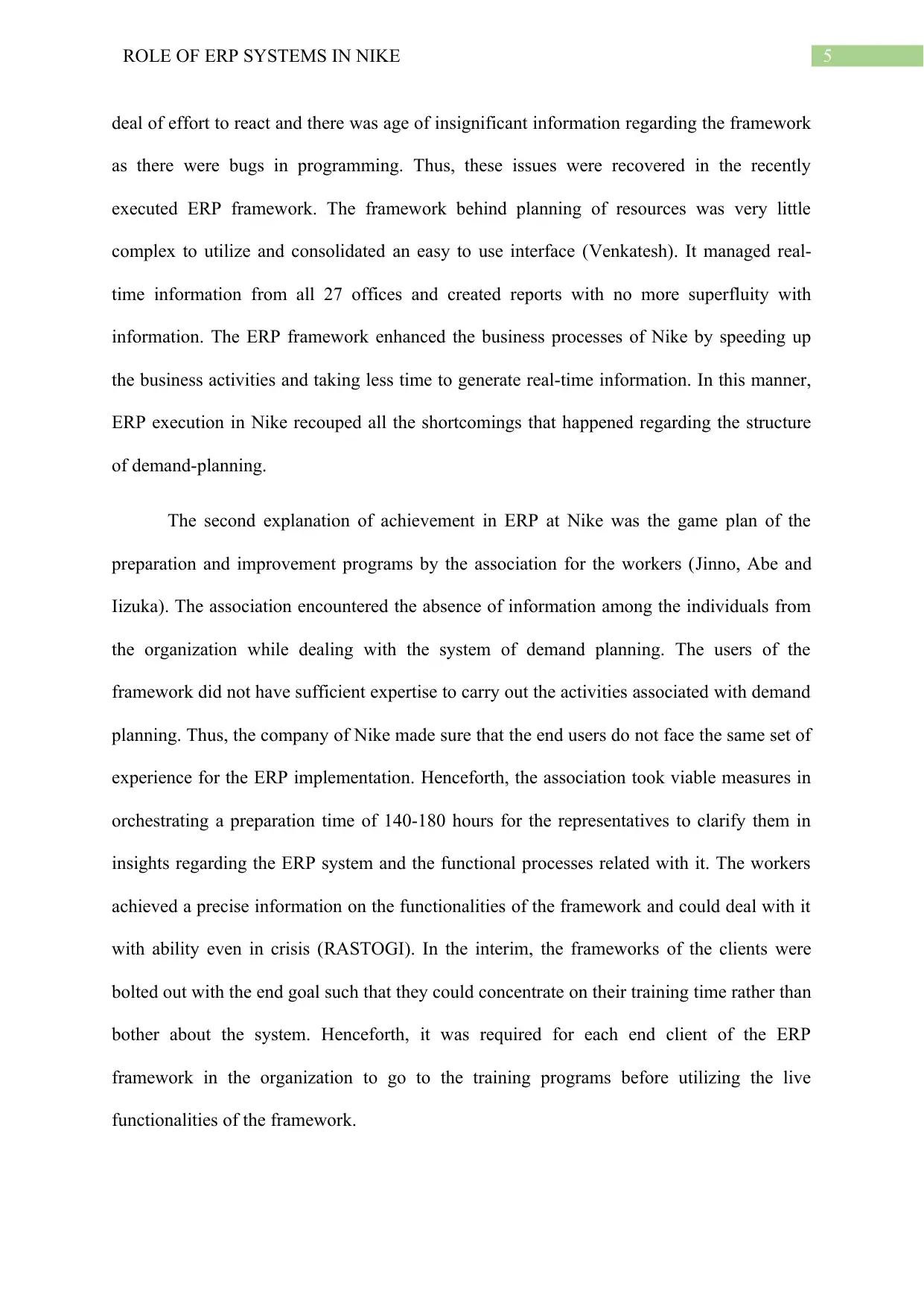
5ROLE OF ERP SYSTEMS IN NIKE
deal of effort to react and there was age of insignificant information regarding the framework
as there were bugs in programming. Thus, these issues were recovered in the recently
executed ERP framework. The framework behind planning of resources was very little
complex to utilize and consolidated an easy to use interface (Venkatesh). It managed real-
time information from all 27 offices and created reports with no more superfluity with
information. The ERP framework enhanced the business processes of Nike by speeding up
the business activities and taking less time to generate real-time information. In this manner,
ERP execution in Nike recouped all the shortcomings that happened regarding the structure
of demand-planning.
The second explanation of achievement in ERP at Nike was the game plan of the
preparation and improvement programs by the association for the workers (Jinno, Abe and
Iizuka). The association encountered the absence of information among the individuals from
the organization while dealing with the system of demand planning. The users of the
framework did not have sufficient expertise to carry out the activities associated with demand
planning. Thus, the company of Nike made sure that the end users do not face the same set of
experience for the ERP implementation. Henceforth, the association took viable measures in
orchestrating a preparation time of 140-180 hours for the representatives to clarify them in
insights regarding the ERP system and the functional processes related with it. The workers
achieved a precise information on the functionalities of the framework and could deal with it
with ability even in crisis (RASTOGI). In the interim, the frameworks of the clients were
bolted out with the end goal such that they could concentrate on their training time rather than
bother about the system. Henceforth, it was required for each end client of the ERP
framework in the organization to go to the training programs before utilizing the live
functionalities of the framework.
deal of effort to react and there was age of insignificant information regarding the framework
as there were bugs in programming. Thus, these issues were recovered in the recently
executed ERP framework. The framework behind planning of resources was very little
complex to utilize and consolidated an easy to use interface (Venkatesh). It managed real-
time information from all 27 offices and created reports with no more superfluity with
information. The ERP framework enhanced the business processes of Nike by speeding up
the business activities and taking less time to generate real-time information. In this manner,
ERP execution in Nike recouped all the shortcomings that happened regarding the structure
of demand-planning.
The second explanation of achievement in ERP at Nike was the game plan of the
preparation and improvement programs by the association for the workers (Jinno, Abe and
Iizuka). The association encountered the absence of information among the individuals from
the organization while dealing with the system of demand planning. The users of the
framework did not have sufficient expertise to carry out the activities associated with demand
planning. Thus, the company of Nike made sure that the end users do not face the same set of
experience for the ERP implementation. Henceforth, the association took viable measures in
orchestrating a preparation time of 140-180 hours for the representatives to clarify them in
insights regarding the ERP system and the functional processes related with it. The workers
achieved a precise information on the functionalities of the framework and could deal with it
with ability even in crisis (RASTOGI). In the interim, the frameworks of the clients were
bolted out with the end goal such that they could concentrate on their training time rather than
bother about the system. Henceforth, it was required for each end client of the ERP
framework in the organization to go to the training programs before utilizing the live
functionalities of the framework.
⊘ This is a preview!⊘
Do you want full access?
Subscribe today to unlock all pages.

Trusted by 1+ million students worldwide
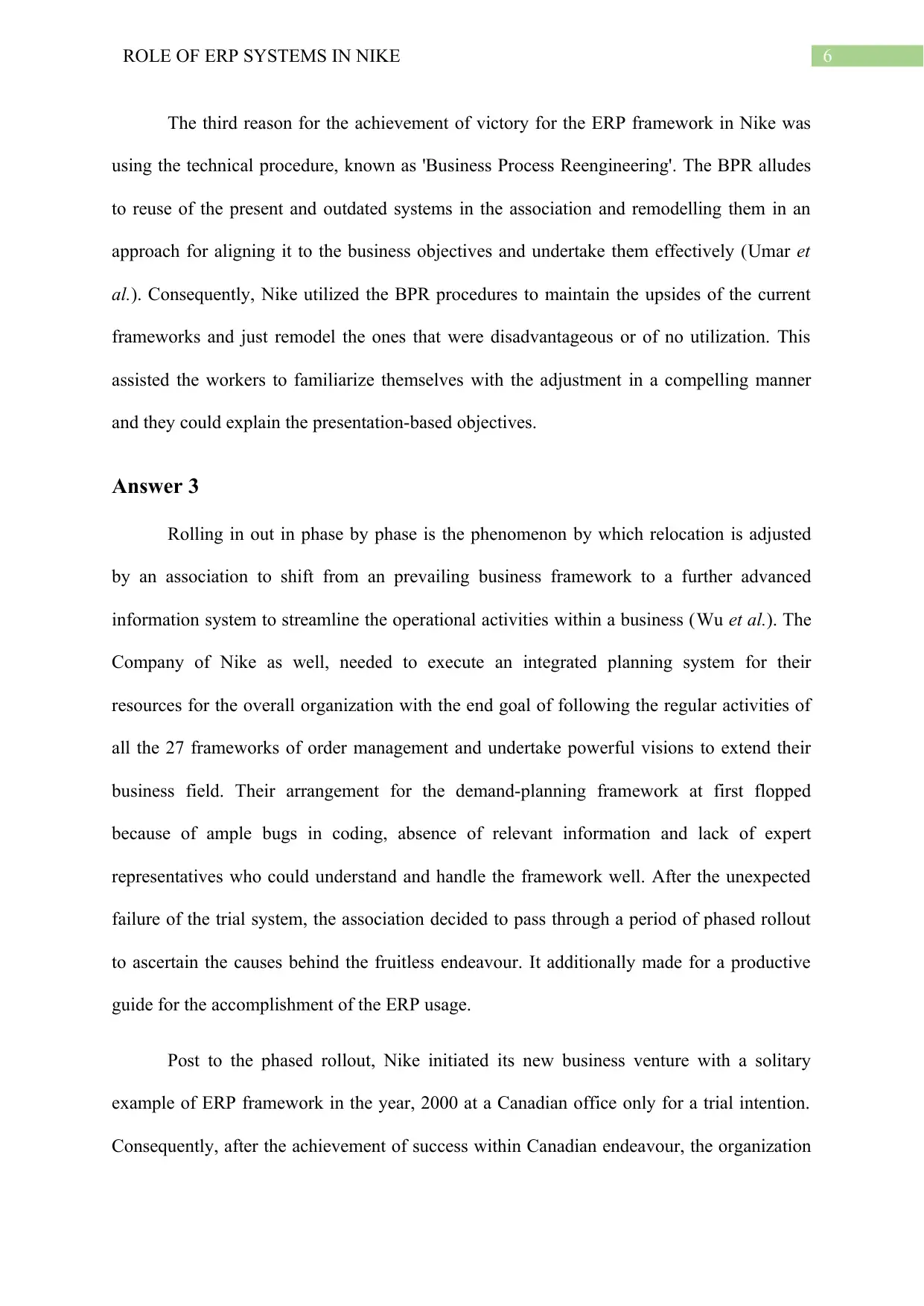
6ROLE OF ERP SYSTEMS IN NIKE
The third reason for the achievement of victory for the ERP framework in Nike was
using the technical procedure, known as 'Business Process Reengineering'. The BPR alludes
to reuse of the present and outdated systems in the association and remodelling them in an
approach for aligning it to the business objectives and undertake them effectively (Umar et
al.). Consequently, Nike utilized the BPR procedures to maintain the upsides of the current
frameworks and just remodel the ones that were disadvantageous or of no utilization. This
assisted the workers to familiarize themselves with the adjustment in a compelling manner
and they could explain the presentation-based objectives.
Answer 3
Rolling in out in phase by phase is the phenomenon by which relocation is adjusted
by an association to shift from an prevailing business framework to a further advanced
information system to streamline the operational activities within a business (Wu et al.). The
Company of Nike as well, needed to execute an integrated planning system for their
resources for the overall organization with the end goal of following the regular activities of
all the 27 frameworks of order management and undertake powerful visions to extend their
business field. Their arrangement for the demand-planning framework at first flopped
because of ample bugs in coding, absence of relevant information and lack of expert
representatives who could understand and handle the framework well. After the unexpected
failure of the trial system, the association decided to pass through a period of phased rollout
to ascertain the causes behind the fruitless endeavour. It additionally made for a productive
guide for the accomplishment of the ERP usage.
Post to the phased rollout, Nike initiated its new business venture with a solitary
example of ERP framework in the year, 2000 at a Canadian office only for a trial intention.
Consequently, after the achievement of success within Canadian endeavour, the organization
The third reason for the achievement of victory for the ERP framework in Nike was
using the technical procedure, known as 'Business Process Reengineering'. The BPR alludes
to reuse of the present and outdated systems in the association and remodelling them in an
approach for aligning it to the business objectives and undertake them effectively (Umar et
al.). Consequently, Nike utilized the BPR procedures to maintain the upsides of the current
frameworks and just remodel the ones that were disadvantageous or of no utilization. This
assisted the workers to familiarize themselves with the adjustment in a compelling manner
and they could explain the presentation-based objectives.
Answer 3
Rolling in out in phase by phase is the phenomenon by which relocation is adjusted
by an association to shift from an prevailing business framework to a further advanced
information system to streamline the operational activities within a business (Wu et al.). The
Company of Nike as well, needed to execute an integrated planning system for their
resources for the overall organization with the end goal of following the regular activities of
all the 27 frameworks of order management and undertake powerful visions to extend their
business field. Their arrangement for the demand-planning framework at first flopped
because of ample bugs in coding, absence of relevant information and lack of expert
representatives who could understand and handle the framework well. After the unexpected
failure of the trial system, the association decided to pass through a period of phased rollout
to ascertain the causes behind the fruitless endeavour. It additionally made for a productive
guide for the accomplishment of the ERP usage.
Post to the phased rollout, Nike initiated its new business venture with a solitary
example of ERP framework in the year, 2000 at a Canadian office only for a trial intention.
Consequently, after the achievement of success within Canadian endeavour, the organization
Paraphrase This Document
Need a fresh take? Get an instant paraphrase of this document with our AI Paraphraser
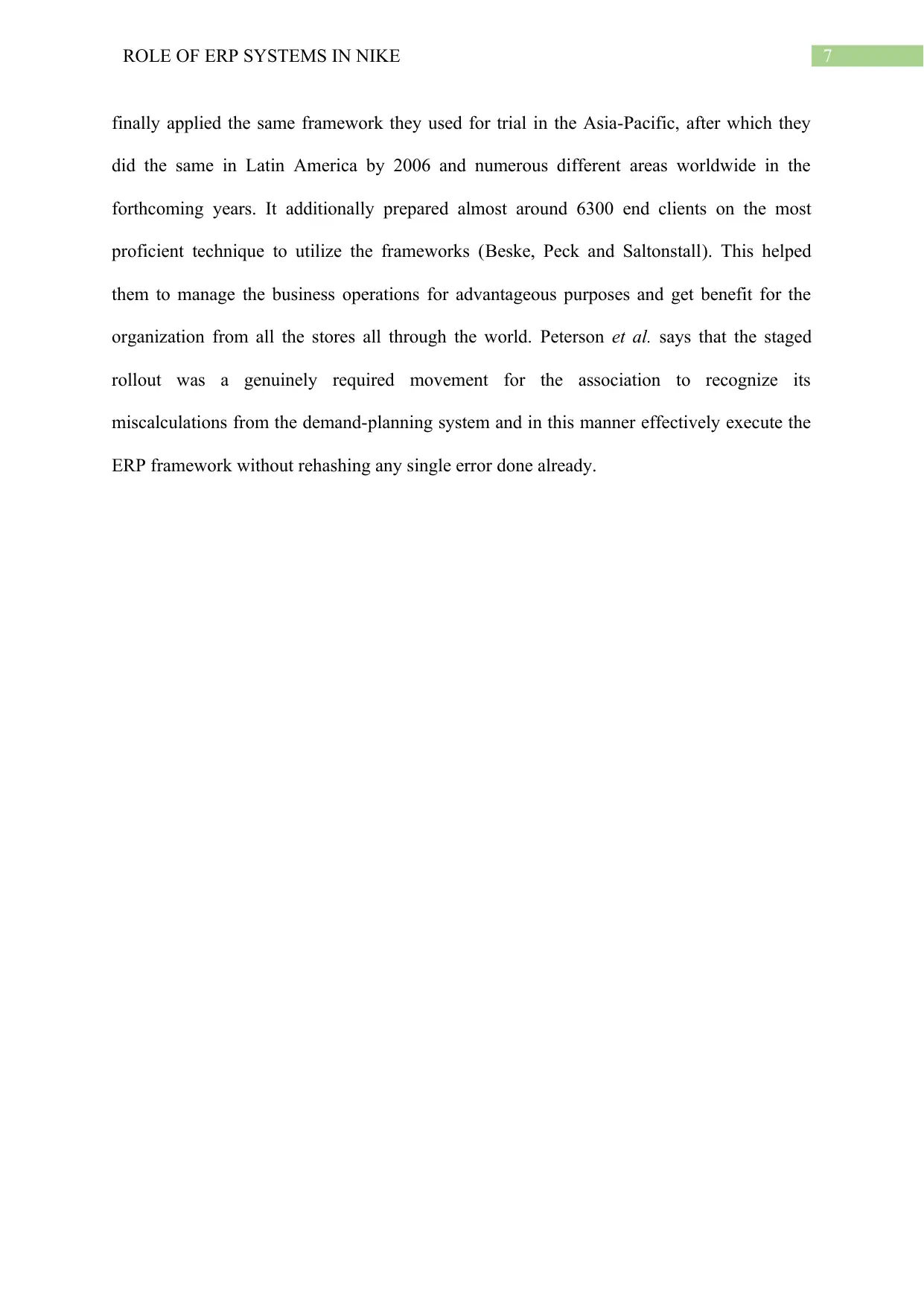
7ROLE OF ERP SYSTEMS IN NIKE
finally applied the same framework they used for trial in the Asia-Pacific, after which they
did the same in Latin America by 2006 and numerous different areas worldwide in the
forthcoming years. It additionally prepared almost around 6300 end clients on the most
proficient technique to utilize the frameworks (Beske, Peck and Saltonstall). This helped
them to manage the business operations for advantageous purposes and get benefit for the
organization from all the stores all through the world. Peterson et al. says that the staged
rollout was a genuinely required movement for the association to recognize its
miscalculations from the demand-planning system and in this manner effectively execute the
ERP framework without rehashing any single error done already.
finally applied the same framework they used for trial in the Asia-Pacific, after which they
did the same in Latin America by 2006 and numerous different areas worldwide in the
forthcoming years. It additionally prepared almost around 6300 end clients on the most
proficient technique to utilize the frameworks (Beske, Peck and Saltonstall). This helped
them to manage the business operations for advantageous purposes and get benefit for the
organization from all the stores all through the world. Peterson et al. says that the staged
rollout was a genuinely required movement for the association to recognize its
miscalculations from the demand-planning system and in this manner effectively execute the
ERP framework without rehashing any single error done already.
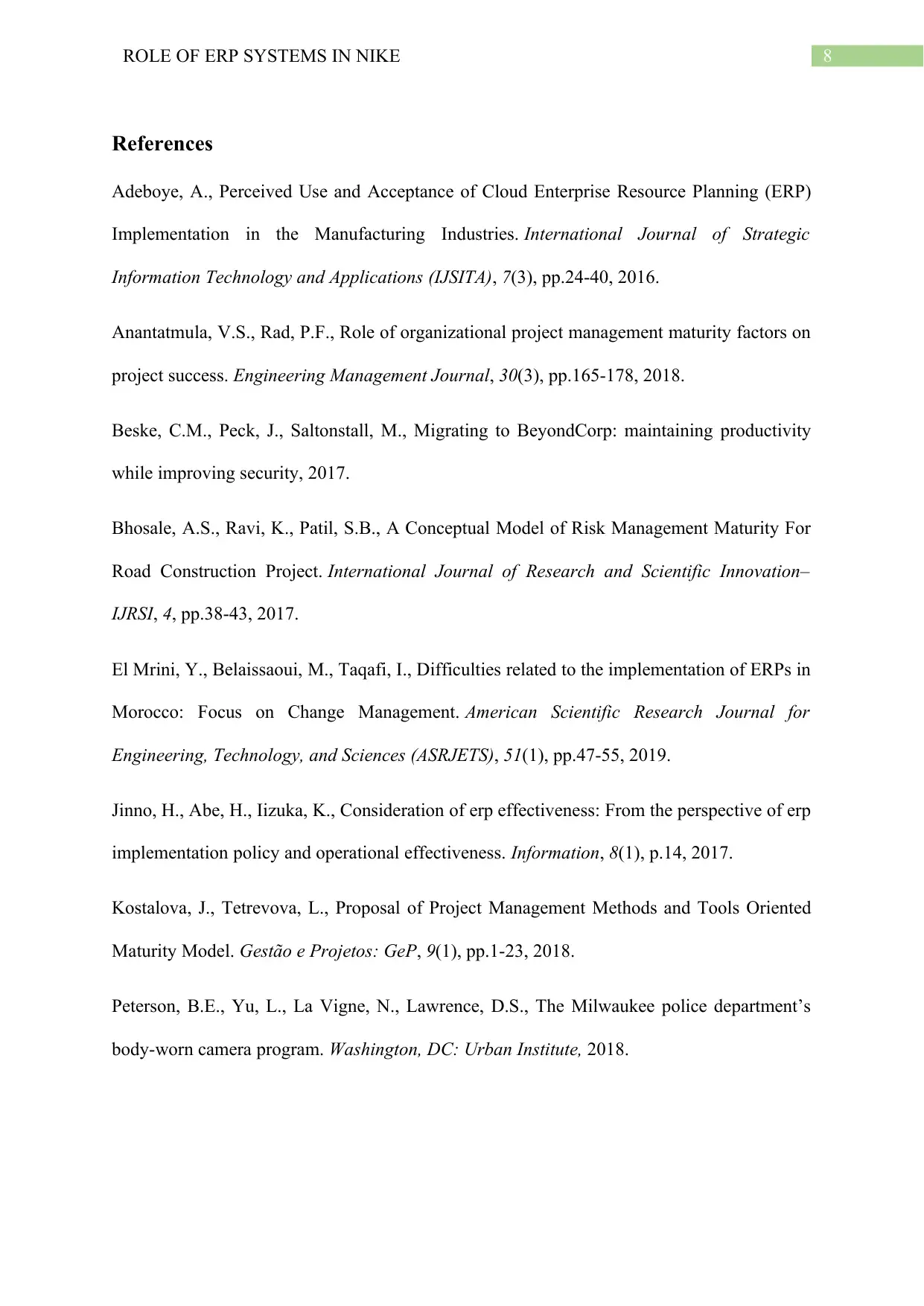
8ROLE OF ERP SYSTEMS IN NIKE
References
Adeboye, A., Perceived Use and Acceptance of Cloud Enterprise Resource Planning (ERP)
Implementation in the Manufacturing Industries. International Journal of Strategic
Information Technology and Applications (IJSITA), 7(3), pp.24-40, 2016.
Anantatmula, V.S., Rad, P.F., Role of organizational project management maturity factors on
project success. Engineering Management Journal, 30(3), pp.165-178, 2018.
Beske, C.M., Peck, J., Saltonstall, M., Migrating to BeyondCorp: maintaining productivity
while improving security, 2017.
Bhosale, A.S., Ravi, K., Patil, S.B., A Conceptual Model of Risk Management Maturity For
Road Construction Project. International Journal of Research and Scientific Innovation–
IJRSI, 4, pp.38-43, 2017.
El Mrini, Y., Belaissaoui, M., Taqafi, I., Difficulties related to the implementation of ERPs in
Morocco: Focus on Change Management. American Scientific Research Journal for
Engineering, Technology, and Sciences (ASRJETS), 51(1), pp.47-55, 2019.
Jinno, H., Abe, H., Iizuka, K., Consideration of erp effectiveness: From the perspective of erp
implementation policy and operational effectiveness. Information, 8(1), p.14, 2017.
Kostalova, J., Tetrevova, L., Proposal of Project Management Methods and Tools Oriented
Maturity Model. Gestão e Projetos: GeP, 9(1), pp.1-23, 2018.
Peterson, B.E., Yu, L., La Vigne, N., Lawrence, D.S., The Milwaukee police department’s
body-worn camera program. Washington, DC: Urban Institute, 2018.
References
Adeboye, A., Perceived Use and Acceptance of Cloud Enterprise Resource Planning (ERP)
Implementation in the Manufacturing Industries. International Journal of Strategic
Information Technology and Applications (IJSITA), 7(3), pp.24-40, 2016.
Anantatmula, V.S., Rad, P.F., Role of organizational project management maturity factors on
project success. Engineering Management Journal, 30(3), pp.165-178, 2018.
Beske, C.M., Peck, J., Saltonstall, M., Migrating to BeyondCorp: maintaining productivity
while improving security, 2017.
Bhosale, A.S., Ravi, K., Patil, S.B., A Conceptual Model of Risk Management Maturity For
Road Construction Project. International Journal of Research and Scientific Innovation–
IJRSI, 4, pp.38-43, 2017.
El Mrini, Y., Belaissaoui, M., Taqafi, I., Difficulties related to the implementation of ERPs in
Morocco: Focus on Change Management. American Scientific Research Journal for
Engineering, Technology, and Sciences (ASRJETS), 51(1), pp.47-55, 2019.
Jinno, H., Abe, H., Iizuka, K., Consideration of erp effectiveness: From the perspective of erp
implementation policy and operational effectiveness. Information, 8(1), p.14, 2017.
Kostalova, J., Tetrevova, L., Proposal of Project Management Methods and Tools Oriented
Maturity Model. Gestão e Projetos: GeP, 9(1), pp.1-23, 2018.
Peterson, B.E., Yu, L., La Vigne, N., Lawrence, D.S., The Milwaukee police department’s
body-worn camera program. Washington, DC: Urban Institute, 2018.
⊘ This is a preview!⊘
Do you want full access?
Subscribe today to unlock all pages.

Trusted by 1+ million students worldwide
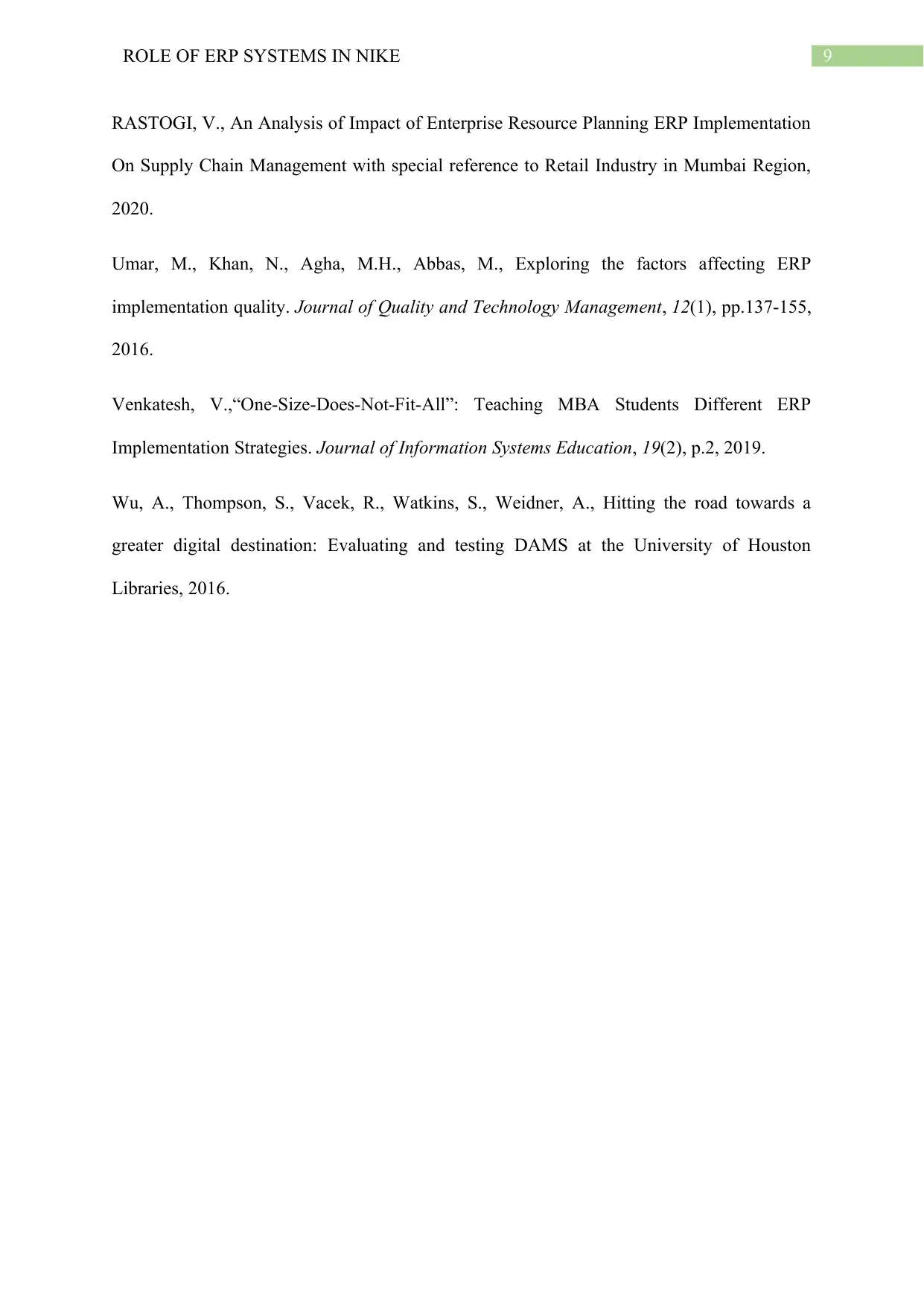
9ROLE OF ERP SYSTEMS IN NIKE
RASTOGI, V., An Analysis of Impact of Enterprise Resource Planning ERP Implementation
On Supply Chain Management with special reference to Retail Industry in Mumbai Region,
2020.
Umar, M., Khan, N., Agha, M.H., Abbas, M., Exploring the factors affecting ERP
implementation quality. Journal of Quality and Technology Management, 12(1), pp.137-155,
2016.
Venkatesh, V.,“One-Size-Does-Not-Fit-All”: Teaching MBA Students Different ERP
Implementation Strategies. Journal of Information Systems Education, 19(2), p.2, 2019.
Wu, A., Thompson, S., Vacek, R., Watkins, S., Weidner, A., Hitting the road towards a
greater digital destination: Evaluating and testing DAMS at the University of Houston
Libraries, 2016.
RASTOGI, V., An Analysis of Impact of Enterprise Resource Planning ERP Implementation
On Supply Chain Management with special reference to Retail Industry in Mumbai Region,
2020.
Umar, M., Khan, N., Agha, M.H., Abbas, M., Exploring the factors affecting ERP
implementation quality. Journal of Quality and Technology Management, 12(1), pp.137-155,
2016.
Venkatesh, V.,“One-Size-Does-Not-Fit-All”: Teaching MBA Students Different ERP
Implementation Strategies. Journal of Information Systems Education, 19(2), p.2, 2019.
Wu, A., Thompson, S., Vacek, R., Watkins, S., Weidner, A., Hitting the road towards a
greater digital destination: Evaluating and testing DAMS at the University of Houston
Libraries, 2016.
1 out of 10
Related Documents
Your All-in-One AI-Powered Toolkit for Academic Success.
+13062052269
info@desklib.com
Available 24*7 on WhatsApp / Email
![[object Object]](/_next/static/media/star-bottom.7253800d.svg)
Unlock your academic potential
Copyright © 2020–2025 A2Z Services. All Rights Reserved. Developed and managed by ZUCOL.




